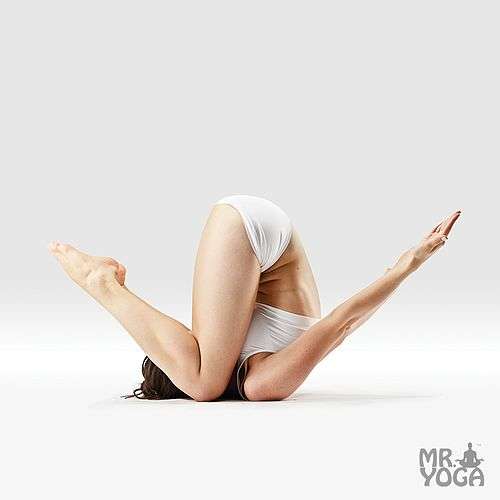Ear Pressure Pose - Karnapidasana

Karnapidasana is an Asana (yoga posture). It is translated as Ear Pressure Pose from Sanskrit (कपोतासन) IAST:Karṇapīḍāsana). [1]
Etymology
The name comes from the Sanskrit words Karna meaning "ears" and Asana (आसन, Āsana) meaning "posture" or "seat".[2]
Description
Karṇapīḍāsana is also known as Raja Halasana (Plow Pose) 1. Practitioner starts with Halasana on the yoga mat. 2. Bend the knees bringing them to the floor and towards the ears. 3. Keep the hands interlaced behind the back, if not support back as in salamba sarvangasana with closing your eyes. 4. Finally hold in this pose for at least 10 seconds. Breathe deeply while performing this asana.
Benefits
Benefits of Knee to Ear Pose (Karnapidasana) 1. Stretches and strengthens the whole spinal column 2. Improves lung strength so can be beneficial for asthma sufferers 3. Stimulates the abdominal organs, and thyroid gland 4. Stretches the shoulders and spine 5. Controls hypertension 6. Relieves the symptoms of menopause 7. Reduces stress and fatigue and is good for calming the mind 8. Treat insomnia, sinusitis, infertility, headache, and some types of backache 9.Stretches and strengthens the whole spinal column
Cautions
1. If the student has limited flexibility they should keep their hands on their low back with bent knees until they are able to lower their knees enough to feel stable in the full posture. 2. Contraindication Focus include Diarrhoea, Menstruation, Neck injuries, Blocked arteries and Pregnancy
Modifications
1. Beginners should support their back with the hands . 2. One variation is to keep your feet on a block behind your head 3. Other variation is to bring your knees to your forehead and bring the hands to the ears
Follow-up asanas
Counter asanas are Matsyasana (Fish Pose), Chaturanga Dandasana (Four-Limbed Staff Pose), Astavakrasana (Eight-Crooks Pose) and Titibasana (Firefly Pose)
Anatomy
Karṇapīḍāsana is one of the counter pose to Sarvangasana (shoulder stand). The thoracic spine is in maximum flexation which can result in problems elsewhere in the spine or knees. The hip flexors and abdominal muscles are required to maintain the pose which stretches the extensors of the spine, the rhomboids and trapezius muscle. To avoid oversterching the cervical spine (neck), the yogi should be able to hold salamba sarvagasana for five minutes. And to protect the lumbar spine (torso) and knees the yogi should be able to stay in halasana for one minute. If the muscles are too short and the pose performed too passively, then the muscles being lengthened can be overstretched.
See also
References
- ↑ "Browser not supported | Yoga.com". yoga.com. Retrieved 2016-12-04.
- ↑ Sinha, S.C. (1 June 1996). Dictionary of Philosophy. Anmol Publications PVT. LTD. p. 18. ISBN 978-81-7041-293-9. Retrieved 9 April 2011.
Further reading
- Iyengar, B. K. S. (1 October 2005). Illustrated Light On Yoga. HarperCollins. ISBN 978-81-7223-606-9. Retrieved 9 April 2011.
- Saraswati, Swami Satyananda (1 August 2003). Asana Pranayama Mudra Bandha. Nesma Books India. ISBN 978-81-86336-14-4. Retrieved 9 April 2011.
- Saraswati, Swami Satyananda (January 2004). A Systematic Course in the Ancient Tantric Techniques of Yoga and Kriya. Nesma Books India. ISBN 978-81-85787-08-4. Retrieved 9 April 2011.